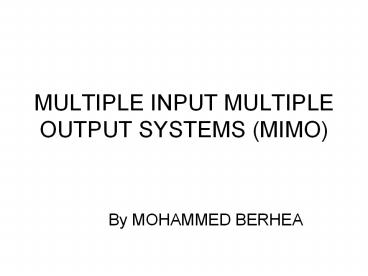MULTIPLE%20INPUT%20MULTIPLE%20OUTPUT%20SYSTEMS%20(MIMO) - PowerPoint PPT Presentation
Title:
MULTIPLE%20INPUT%20MULTIPLE%20OUTPUT%20SYSTEMS%20(MIMO)
Description:
use multiple inputs and multiple outputs from a single channel. are defined by Spatial Diversity and Spatial Multiplexing ... Staffordshire University ... – PowerPoint PPT presentation
Number of Views:955
Avg rating:3.0/5.0
Title: MULTIPLE%20INPUT%20MULTIPLE%20OUTPUT%20SYSTEMS%20(MIMO)
1
MULTIPLE INPUT MULTIPLE OUTPUT SYSTEMS (MIMO)
- By MOHAMMED BERHEA
2
1. Introduction
- MIMO Systems
- use multiple inputs and multiple outputs from a
single channel - are defined by Spatial Diversity and Spatial
Multiplexing
3
Spatial Diversity and Spatial Multiplexing
- Spatial Diversity
- Signal copies are transferred from multiple
antennas or received at more than one antenna - redundancy is provided by employing an array of
antennas, with a minimum separation of ?/2
between neighbouring antennas - Spatial Multiplexing
- the system is able to carry more than one data
stream over one frequency, simultaneously
4
Why MIMO?
- There is always a need for increase in
performance in wireless systems - Significant increase in spectral efficiency and
data rates - High Quality of Service (QoS)
- Wide coverage, etc.
- Wireless channel that we are using is very
unfriendly - Suffers from Cochannel interference and signal
level fading - It provides a limited bandwidth
- power falls off with distance
5
MIMO System solutions
- By using Multiple Output Multiple Input (MIMO)
systems - Diversity gain mitigates the fading and increases
coverage and improves QoS - Multiplexing gain increases capacity and spectral
efficiency with no additional power or bandwidth
expenditure - Array gain results in an increase in average
receive SNR. - Spatial Diversity and Spatial Multiplexing can
be conflicting goals
6
Spatial Multiplexing
- MIMO channels can be decomposed into a number of
R parallel independent channels ? Multiplexing
Gain - Principle Transmit independent data signals from
different antennas to increase the throughput,
capacity.
Source An Overview of MIMO Systems in Wireless
Communications www.iet.ntnu.no/projects/beats/Docu
ments/mimo.pdf
7
MEMO capacity on fading channels
- The capacity increase can be seen by comparing
MEMO systems with SISO, SIMO, and MISO systems - SISOcapacity is given by Shannons classical
formula - Where B is the BW and h is the fading gain
- SIMO (with M transmitting antennas), the capacity
is given by 2 - MISO (with M transmitting antennas), the capacity
is given by 2
8
MEMO capacity on fading channels
- The capacity for MIMO systems can have the
following forms (Assuming Tx antennas Rx
antennas N) - A) If the channel is not known at the
transmitter - Where Es is the total power, s2 is noise level of
AWGN - Hence the power is equally shared by each channel
- The capacity grows linearly with the number of
antennas - B) If the channel is known at the transmitter
9
MEMO capacity on fading channels
- With the channel known at the transmitter, the
total power allocation the each channel will be
based on watterfilling. - Watterfilling Strong Sub-channel, with low noise
power level will be assigned with a higher signal
power. - Where sN2 s2 / hn2
Illustrating Watterfilling
Source MIMO Systems and Transmit Diversity,
www.comm.utoronto.ca/rsadve/Notes/DiversityTransm
it.pdf
10
Average capacity of a MIMO Rayleigh fading
channel
Source Space-time Diversity Codes for Fading
Channels, 3
11
Spatial Diversity
- Improves the signal quality and achieves a higher
SNR at the receiver-side - Principle of diversity relies on the transmission
of structured redundancy
yi
xi
12
MIMO Diversity and Reliability
- The performance improvement in SNR and error
probability for MIMO can be compared with SISO,
SIMO, and MISO - The detailed calculation for SNR and Pe is shown
in 1 - SISO
- Receive Diversity (SIMO)
and
and
13
MIMO Diversity and Reliability
- The values for SNR and Pe for
- Transmit Diversity (MISO)
- Transmit/Receive Diversity (MIMO)
- The received signal at antenna i will be
- H is the channel fading matrix
and
and
14
Conclusion
- The capacity of Receive or Transmit Diversity
grows logarithmically with the number of antennas - Capacity of MEMO increases linearly with the
number of antennas - Using Spatial Diversity
- The SNR increases and Pe decreases when using
MIMO - Spatial Multiplexing and Spatial Diversity are
conflicting objectives
15
References
- 1 MIMO Architecture for Wireless Communication
Intel Technology Journal, vol. 10, Issue 02, May
2006 - 2 MIMO Systems and Transmit Diversity,
- www.comm.utoronto.ca/rsadve/Notes/DiversityTrans
mit.pdf - 3 R.A. Carrasco, Space-time Diversity Codes for
fading Channel, - Staffordshire University
- 4 D. Gesbert, M.Shafi, D. Shiu, P. Smith, and
A. Naguib, From Theory to Practice An Overview
of MIMO SpaceTime Coded Wireless Systems - IEEE JOURNAL ON SELECTED AREAS IN
COMMUNICATIONS, VOL. 21, NO. 3, APRIL 2003 - 5 Introduction to MIMO Systems Application
Note 1MA102, Rohde schwarz































